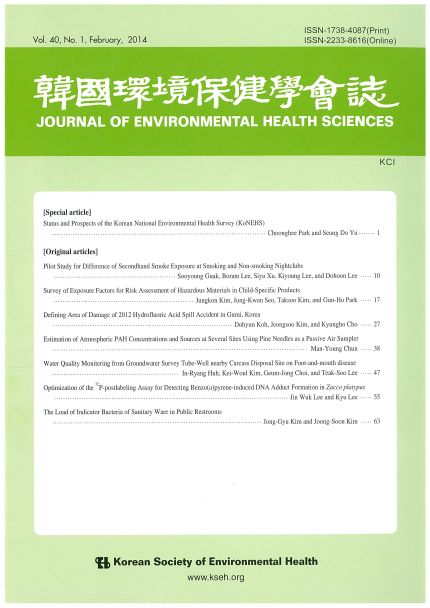- 영문명
- Survey of Exposure Factors for Risk Assessment of Hazardous Materials in Child-Specific Products
- 발행기관
- 한국환경보건학회
- 저자명
- 김정곤(Jungkon Kim) 서정관(Jung-Kwan Seo) 김탁수(Taksoo Kim) 박건호(Gun-Ho Park
- 간행물 정보
- 『한국환경보건학회지』제40권 제1호, 17~26쪽, 전체 10쪽
- 주제분류
- 공학 > 환경공학
- 파일형태
- 발행일자
- 2014.02.28

국문 초록
영문 초록
Background: Despite children’s unique characteristics that distinguish them from adults, relatively few attempts have been made to measure exposure factors for characterization of children’s exposure to hazardous chemicals in child-specific products (CSP). This study was conducted to establish the child-specific exposure factors for exposure and risk assessment of hazardous substances in CSP.
Methods: We investigated the exposure factors (e.g., time use of child-products, time and frequency of objectto-body contact, time and frequency of object-to-mouth contact) influencing children’s exposure to CSP (e.g., toys, playmats, oil pastels, etc.) in 650 children through a parent-completed questionnaire using a web-based survey. Participants were recruited in five age groups, <1, 1-2, 2-3, 3-6, and 6-12 years of age.
Results: The child-specific exposure factors were presented as the mean, median, 95 th percentile, minimum, and maximum values. Time activity for play mats was the longest among CSP and infants spent more time on them than did elder age groups (189.3-224.7 min/day for <1-2 years vs. 91.2 min/day for 6-12 years). It is apparent that time and frequency of toy block- and plastic toy-to-mouth contact significantly decreased as a function of age. When the variation of CSP use patterns was compared by gender, the only variable that was statistically different between genders was time activity in child-products exposure space.
Conclusion: We believe the five child-specific exposure factors suggested in the present study will be valuable for reducing uncertainty in the estimation of chemical exposure during risk assessment of CSP and furthermore, in the appropriate regulations to protect children’s health.
목차
I. 서 론
II. 연구방법
III. 결 과
IV. 고 찰
V. 결 론
해당간행물 수록 논문
참고문헌
최근 이용한 논문
교보eBook 첫 방문을 환영 합니다!

신규가입 혜택 지급이 완료 되었습니다.
바로 사용 가능한 교보e캐시 1,000원 (유효기간 7일)
지금 바로 교보eBook의 다양한 콘텐츠를 이용해 보세요!




